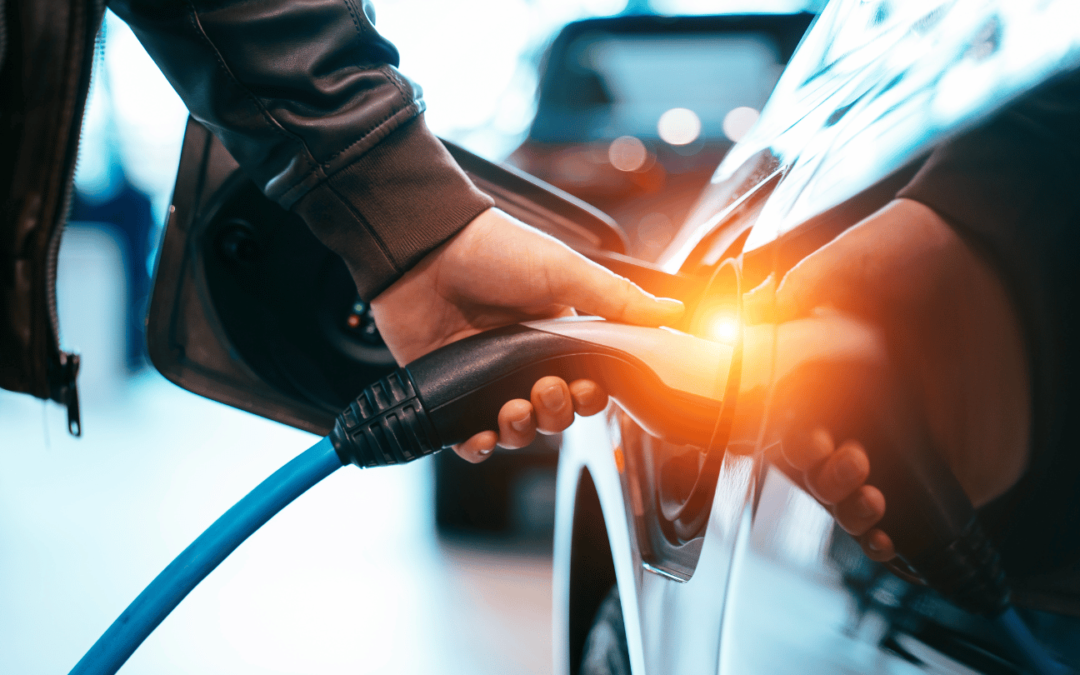It’s becoming increasingly apparent that electric vehicles (EVs) are on the rise here in Orange County, from the bustling streets of Irvine to the serene coastlines of Laguna Beach. This shift isn’t merely a trend; it’s a community-wide movement towards sustainability and cost-effective transportation.
In this context, it’s essential to understand two critical terms: MPGe and MPG. Miles Per Gallon (MPG) has long been the standard for measuring the fuel efficiency of traditional gasoline vehicles. It tells us how far a car can travel on a single gallon of gas. On the other hand, Miles Per Gallon Equivalent (MPGe) is a newer measure for electric vehicles. It represents the distance an EV can cover on the amount of energy equivalent to one gallon of gasoline.
Whether you’re considering an electric vehicle for the first time or simply curious about the technology, grasping these concepts is crucial. Let’s explore MPGe vs. MPG together, shedding light on what these measures mean for your daily commute and our community’s environmental footprint. Plus, we’ll talk about the benefits of commercial EV charging stations and how they affect your business.
Welcome to a clearer, more informed path to navigating the roads of Orange County.
What is MPG (Miles Per Gallon)?
Miles Per Gallon (MPG) is a measure used to indicate how many miles a vehicle can travel on one gallon of gasoline. It’s a metric that has been guiding drivers for decades. It offers a straightforward way to gauge a car’s fuel efficiency.
When you see a car with a higher MPG rating, it means that the vehicle can travel further using less fuel. In short, it’s an economical choice for longer journeys.
Why MPG is Important in Traditional Gasoline Vehicles
MPG is a cornerstone of automotive performance. It’s not just a number; it reflects how well a vehicle converts fuel into distance.
For drivers, understanding a car’s MPG is crucial for several reasons:
- Cost-Effectiveness: A higher MPG means fewer trips to the gas station and more money saved over time. An efficient MPG can make a significant difference in your monthly expenses. This is especially true in Orange County, where life is always on the move.
- Environmental Impact: Vehicles with higher MPG ratings are generally more environmentally friendly. They burn less fuel for every mile traveled, which means fewer emissions and a smaller carbon footprint. It’s a step towards greener, more sustainable driving.
- Long-Term Value: Cars that boast good MPG figures tend to hold their value better and are often more sought after in the used car market. It’s not just about the savings today. It’s about making a wise investment for tomorrow.
Understanding MPG is vital for any driver, especially those navigating the bustling roads of Orange County. It’s about making informed choices that benefit your wallet, your time, and the beautiful environment around us.
Whether commuting to work, heading out for a weekend adventure, or simply running errands, your vehicle’s MPG plays a pivotal role in your daily life.
What is MPGe (Miles Per Gallon Equivalent)?
Miles Per Gallon Equivalent (MPGe) is a metric developed to compare the energy consumption of electric and hybrid vehicles with that of traditional gasoline vehicles.
MPGe represents the number of miles a vehicle can travel using a quantity of fuel with the same energy content as one gallon of gasoline. This unit of measurement is particularly useful in quantifying the efficiency of vehicles that don’t run solely on gasoline. It offers a familiar frame of reference for potential buyers.
How MPGe Measures the Efficiency of Electric Vehicles
For electric vehicles, understanding their efficiency requires a different approach, and that’s where MPGe comes into play.
Let’s break it down:
- Standardizing Comparisons: MPGe allows consumers to compare the energy efficiency of electric vehicles directly with the MPG of gasoline vehicles. It provides a standardized metric for understanding how far an EV can travel on a certain amount of electrical energy. It makes comparisons easier and more meaningful.
- Reflecting Energy Efficiency: MPGe reflects how many miles an EV can travel on the amount of electricity that contains the same energy as a gallon of gas. This measurement is crucial because it translates the unfamiliar territory of kilowatt-hours (kWh) of electricity into the more familiar context of gallons of fuel.
- Promoting Informed Choices: By understanding the MPGe of an electric vehicle, consumers in Orange County and beyond can make informed decisions about the cost and environmental impact of their transportation. Higher MPGe ratings indicate a more efficient vehicle. This means lower energy costs over time and a smaller environmental footprint.
MPGe serves as a bridge, connecting the world of traditional fuel to the emerging landscape of electric power. It’s an essential tool for anyone considering the switch to an electric vehicle.
As more people in Orange County and beyond embrace electric vehicles, understanding MPGe will become increasingly crucial in navigating the road to a sustainable future.
How to Convert MPGe to MPG?
Let’s talk about switching MPGe to MPG. You might think it’s like exchanging dollars for euros, but it’s a bit more involved. MPGe tells us how far electric vehicles can go using electric energy, while MPG tells us how far traditional cars can go on gas.
They’re different because they’re based on different fuel types. So when it comes to MPGe vs MPG, we can’t just swap one for the other without a bit of thought.
The Relationship Between Gasoline and Electricity
When we talk about the energy in gasoline, we measure it in something called British Thermal Units (BTUs). For electricity, we use kilowatt-hours (kWh). The Environmental Protection Agency (EPA) helps us out by saying that 33.7 kWh of electricity is about the same as the energy in one gallon of gasoline. This is our starting point for understanding MPGe.
So, if an electric car has a rating of 100 MPGe, it can travel 100 miles on the amount of electricity equal to the energy of one gallon of gasoline.
But remember, this doesn’t mean you can directly compare it to a car with 100 MPG. That’s because many things can affect how far each car can actually go. Think of the car’s design, your driving style, and even the type of electricity you use.
While we can’t just flip a switch and convert MPGe to MPG, understanding this relationship helps us make smarter choices about our cars.
It’s about looking at the big picture of what makes a car efficient and how it fits with your life and the beautiful area we call home. So next time you’re considering an EV or a traditional car, remember it’s not just about the numbers — it’s about understanding what they really mean for you and your journey.
What is a Good MPG?
When we talk about a ‘good’ MPG, or miles per gallon, for traditional gasoline vehicles, think of it as how far you can go on a single gallon of gas.
A higher number means the car is more efficient. It uses much less fuel to go the same distance. Generally, a compact car with an MPG of around 30 to 40 is considered good, providing a nice balance between performance and fuel efficiency.
Larger vehicles like SUVs and trucks will naturally have a lower MPG due to their size and weight.
Factors Affecting MPG in Gasoline Vehicles
Several factors can influence the MPG of your car.
- Car design: The design and condition of your vehicle play a big role. Aerodynamic shapes, regular maintenance, and proper tire inflation can all boost your MPG.
- Driving habits: Your driving habits matter too. Smoother acceleration and sticking to speed limits usually mean better fuel efficiency.
- Outside factors: External factors like road conditions and weather can impact how far each gallon will take you.
What is a Good MPGe?
For electric vehicles, a good MPGe is often higher than the MPG of gasoline vehicles. It’s somewhere in the range of 90 to 120 MPGe and is considered quite efficient.
The higher the MPGe, the less electricity the car uses to travel the same distance, which is great for your wallet and the environment.
How MPGe Reflects Efficiency and Savings
A higher MPGe means the vehicle can travel further on less energy. That translates to less money spent on charging and fewer emissions. It’s a win-win, offering potential savings and a smaller environmental footprint.
Looking at the MPGe can give you a good idea of its efficiency and how much you might save over time. It’s all about finding a vehicle that fits your needs and helps you contribute to a cleaner, more sustainable Orange County.
MPGe vs. MPG Examples
Imagine you’re comparing two cars: one electric (with a high MPGe) and one gasoline-powered (with a good MPG).
If a gasoline car has an MPG of 30, it means you can drive 30 miles on one gallon of gas. Now, if an electric vehicle has an MPGe of 100, it can travel 100 miles on the amount of electricity with the same energy as one gallon of gas.
Let’s say you’re driving from Anaheim to Irvine, about 20 miles. The electric car will use roughly one-fifth of its equivalent “gallon” of electricity, while the gasoline car will use two-thirds of a gallon of gas. Over time and distance, those differences add up. It will generally favor the electric vehicle for efficiency and cost, especially with the higher MPGe.
Why This is Important for Orange County Drivers Switching to EVs
For drivers in Orange County considering the switch to an electric vehicle, these comparisons are more than just numbers. A higher MPGe means reduced fuel costs and less frequent stops for charging compared to fueling — a significant convenience in our busy lives.
Plus, there’s another benefit: the growing infrastructure for EVs, like charging stations popping up at shopping centers, workplaces, and public spaces. Owning an EV in Orange County is becoming more practical every day.
The Future of Driving in Orange County: MPG, MPGe, and Beyond
The transition to EVs and more stringent fuel efficiency standards is accelerating, particularly in California, which often sets the pace for environmental policies.
The EPA has proposed new, aggressive vehicle emissions standards that aim to significantly increase the sales of electric cars and trucks nationwide, reflecting California’s own ambitious standards.
Local Initiatives and Infrastructure
California is leading the electrification movement, with automakers ramping up EV production in response to state mandates.
However, the industry voices concerns over the pace of this transition, highlighting the need for supportive policies and market conditions to achieve a net-zero carbon future. Challenges include:
- The availability of charging stations
- The supply of critical minerals for batteries.
Additionally, California faces significant hurdles in making EVs accessible to all demographics. There are disparities in EV ownership across different communities and concerns about the electric grid’s capacity to handle an increase in EVs.
These evolving standards and local initiatives are shaping the future of driving in Orange County. It all includes increased adoption of EVs, improved infrastructure, and a more inclusive approach to clean transportation.
SCE’s EV Chargers for Orange County Businesses
Let’s talk business. Southern California Edison’s Charge Ready program offers a wealth of benefits for Orange County business owners looking to install EV chargers:
- Financial Incentives: Reducing installation costs.
- Infrastructure Support: Assisting with essential infrastructure.
- Technical Support: Providing expertise for installation and maintenance.
- Competitive Edge: Enhancing business appeal to meet EV demand.
- Sustainability Leadership: Positioning your business as an environmental leader.
- Property Value Increase: Potentially raising your property’s value.
- Tenant Attractiveness: Making your location desirable to eco-conscious tenants.
- Exclusive Rate Plans: Access to special EV rate plans and zero demand charges up to 2024.
REPOWER Orange is your local partner for installing EV chargers on your property. We help you tap into Southern California Edison’s programs designed to support businesses transitioning to electric vehicles.
As experts in the field, we ensure a seamless installation process, guiding you through every step and optimizing the benefits these programs offer. With our assistance, you’ll not only enhance your property’s value and appeal but also contribute to a greener Orange County.
MPGE vs MPG: Final Thoughts
Understanding MPGe vs. MPG is crucial for making informed decisions about your vehicle’s efficiency and environmental impact.
For Orange County drivers, considering both metrics when choosing a car can lead to better fuel economy, cost savings, and a reduced carbon footprint.
Whether you opt for a traditional gasoline vehicle or an electric one, being informed helps you contribute to a greener community and embrace a sustainable driving future.
Want to start driving into a green future? With REPOWER Orange, commercial businesses in Orange County can capitalize on incentives to install EV chargers on commercial properties. For more information on how it all works, contact us today.



Recent Comments